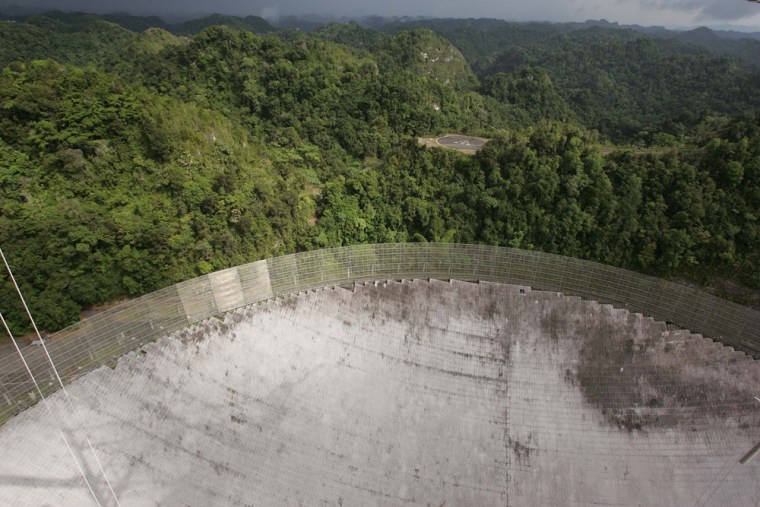At the world’s largest radio telescope, astronomers searching for asteroids on a collision course with Earth are bracing for a more worldly threat: the steepest budget cuts and first layoffs since the observatory opened in 1963.
Managers are warning staff and outside astronomers to prepare for a leaner future, with fewer research projects and less telescope time available as they finish a costly repainting job amid a looming cut in U.S. government funding.
“This place will change dramatically,” Robert L. Brown, director of the National Astronomy and Ionosphere Center, which includes the observatory, said in a recent interview.
The Arecibo radio telescope, with its signature 1,000-foot (300-meter) reflector dish set in a junglelike landscape, is best known as a setting in “Contact,” a 1997 Jodie Foster movie based on the Carl Sagan book about the search for extraterrestrial life — a hunt that still takes place at the observatory.
It also gained fame in the 1995 James Bond movie “Goldeneye,” in which the telescope’s platform, suspended like a giant steel spider 450 feet (137 meters) above the dish, figured in a climactic fight scene.
Reality check at Arecibo
Day-to-day activities at the observatory, which is managed by Cornell University, are less cinematic. Unlike optical telescopes that visually scan the skies, the telescope at Arecibo receives and processes natural radio signals emitted by planets, stars and other objects.
As the world’s largest, it is more sensitive than any other radio telescope and can detect more and fainter objects in space. By bouncing radio waves off asteroids, it also charts their location, speed, course and other characteristics.
“The whole world loses if funding is lost for Arecibo,” said Lance Benner, a research scientist at NASA’s Jet Propulsion Laboratory in Pasadena, Calif. He uses the telescope to track near-earth asteroids. “We’re a very inexpensive form of insurance for the whole planet.”
The telescope is so prized that astronomers let out a collective shudder in November when a review panel recommended the U.S. cut 25 percent of the observatory’s $10.5 million astronomy budget next year and consider eliminating it entirely at the end of the decade (PDF file). The panel suggested that the private sector or overseas institutions could pay part of Arecibo’s costs
“So many of us use the results that come out of there that we are very concerned,” said Brother Guy Consolmagno, an astronomer at the Vatican Observatory in Castel Gandolfo, Italy. “There is nothing that can come close to what it can do.”
Research dollars spread more thinly
National Science Foundation officials commissioned the review panel to find ways to pay for new projects at a time when Congress isn’t likely to increase the research budget, said Wayne Van Citters, director of the agency’s astronomy division.

“They concluded that we simply could not keep everything that we currently support going at the time that we pursued the extremely ambitious future program before us,” Van Citters said.
Those future programs include the U.S. share of an international radio telescope under construction in the Atacama Desert of Chile. When it opens around 2011, it will be the largest observatory ever built.
The $30 million in proposed cuts from the NSF’s overall $200 million astronomy budget were spread out over a number of programs through the end of the decade to avoid “irreparable harm” to the nation’s astronomy research, he said. The NSF is still reviewing the panel’s recommendations.
Repainting vs. research
But Arecibo is already scrimping to repaint the telescope, a $5 million project that officials say must be done now to prevent the steel from corroding in the humid air of northwestern Puerto Rico.
The facility, which was built by the U.S. Air Force, will borrow the money and pay it back over the next three years by cutting 25 percent from its astronomy budget, Brown said.
Twenty to 30 positions will be lost, including some science and support staff, as well as about a quarter of the approximately 100 astronomy research projects done annually at the center. The telescope’s annual operating time will be reduced by 1,000 hours, he said.
The situation will become much worse if the NSF recommends the U.S. cut Arecibo’s budget by another 25 percent. Cornell officials planned to lobby Congress to maintain the funding.
“With this kind of cutback, it would be difficult to sustain any kind of long-term operation,” said Mike Nolan, another astronomer who tracks near-Earth asteroids.
The deeper cuts wouldn’t force the Arecibo complex to close entirely — at least not immediately. The visitor center, which is self-sustaining and draws about 120,000 visitors per year, would remain open, and the research on the upper atmosphere — the ionosphere — would remain since its funding comes from another source.
Officials at the observatory, however, say it is unlikely they would be able to replace the lost U.S. funding for astronomy, the largest portion of Arecibo’s budget. The most likely outcome would be a gradual phasing-out of astronomy work.
“We’re going to hold out as long as we can and try to convince people that it would be foolish to do that,” Nolan said.